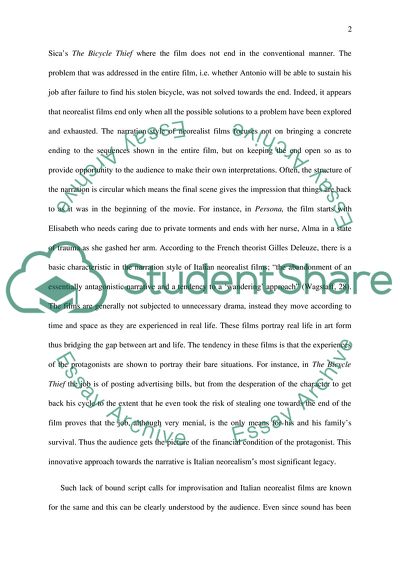Cite this document
(Italian Neorealism Coursework Example | Topics and Well Written Essays - 2750 words, n.d.)
Italian Neorealism Coursework Example | Topics and Well Written Essays - 2750 words. https://studentshare.org/visual-arts-film-studies/1854996-focusing-on-its-influence-on-another-post-war-1945-1980-national-cinema-studied-on-this-module-what-in-your-opinion-was-italian-neorealisms-most-significant-legacy-was-it-in-terms-of-subject-matter-style-narrative-construction-or-something-else
Italian Neorealism Coursework Example | Topics and Well Written Essays - 2750 words. https://studentshare.org/visual-arts-film-studies/1854996-focusing-on-its-influence-on-another-post-war-1945-1980-national-cinema-studied-on-this-module-what-in-your-opinion-was-italian-neorealisms-most-significant-legacy-was-it-in-terms-of-subject-matter-style-narrative-construction-or-something-else
(Italian Neorealism Coursework Example | Topics and Well Written Essays - 2750 Words)
Italian Neorealism Coursework Example | Topics and Well Written Essays - 2750 Words. https://studentshare.org/visual-arts-film-studies/1854996-focusing-on-its-influence-on-another-post-war-1945-1980-national-cinema-studied-on-this-module-what-in-your-opinion-was-italian-neorealisms-most-significant-legacy-was-it-in-terms-of-subject-matter-style-narrative-construction-or-something-else.
Italian Neorealism Coursework Example | Topics and Well Written Essays - 2750 Words. https://studentshare.org/visual-arts-film-studies/1854996-focusing-on-its-influence-on-another-post-war-1945-1980-national-cinema-studied-on-this-module-what-in-your-opinion-was-italian-neorealisms-most-significant-legacy-was-it-in-terms-of-subject-matter-style-narrative-construction-or-something-else.
“Italian Neorealism Coursework Example | Topics and Well Written Essays - 2750 Words”. https://studentshare.org/visual-arts-film-studies/1854996-focusing-on-its-influence-on-another-post-war-1945-1980-national-cinema-studied-on-this-module-what-in-your-opinion-was-italian-neorealisms-most-significant-legacy-was-it-in-terms-of-subject-matter-style-narrative-construction-or-something-else.


